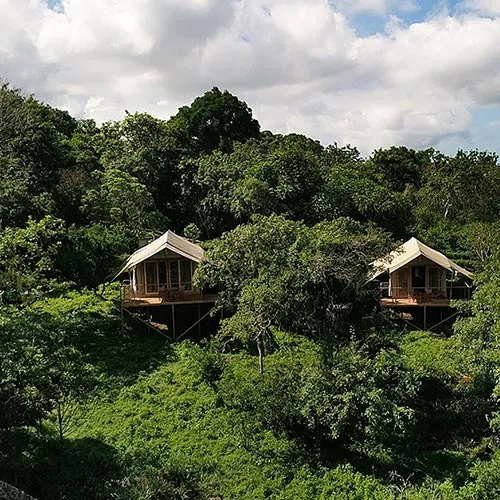Galapagos Penguins
View this post on Instagram
There are only about 2000 Galapagos penguins in the world today and they are all here, in the Galapagos Islands.
The Galapagos Penguin is the only penguin found past the equatorial line, in the northern hemisphere. It is actually the only penguin that spends all of its life on the equator.
- Scientific name: Speniscus mendiculus
- Status: Endangered
How did Galapagos Penguins end up on the equator?
The Galapagos Penguin is a relative of the very similar Humboldt Penguin, which only seasonally makes its way from the colder regions of Chile as far north as southern continental Ecuador, following the icy waters of the Humboldt Current.
Putting two and two together, it seems logical that Galapagos penguins many, many years ago, were originally Humboldt penguins that lost their way or were pushed off course by strong currents and left stranded in the Galapagos never to return home. The species was forced to revamp its entire existence in, what pretty much could be considered their “worst case scenario”. We all know how much penguins like the cold!
How did the penguin adapt to the Galapagos Islands?
It is a small miracle that these first arrivals survived for long enough to reproduce in the Galapagos. The dry season is difficult, even for the lizards. But, like many Galapagos creatures, the species adapted over time, eventually becoming the smallest penguin on the planet. Measuring 50cm in length (beak to toe) or 35 cm tall when standing, it is just half the height of the Emperor Penguin in the south pole.
As the German naturalist, Carl Bergmann, was to hypothesise (interestingly, 12 years before Darwin’s On the Origin of Species was published), there is a relationship between body size and heat economy, a concept that is now termed ‘Bergmann’s rule’. A small animal, such as the Galapagos Penguin, has a greater surface area for its size compared to say, his Emperor Penguin relative, allowing him to lose heat faster. This advantageous adaptation being yet another example to support Darwin’s theory of natural selection.
One other way they protect themselves from the blistering heat is by covering their feet with their bodies in an effort to avoid sunburn.
Best places to see Galapagos Penguins
View this post on Instagram
Given that penguins as a whole favour cold waters, it’s not surprising that Galapagos Penguins are mostly found on the westernmost islands, where water temperatures are at their coldest, thanks to the complex system of ocean currents, most notably between the islands of Isabela and Ferdandina.
Unless you are part of David Attenborough’s gang (who have special permits to access many parts of the islands that are otherwise off limits to regular visitors), the best place to see Galapagos Penguins is on our Isabela Island Safari extension. Here, you will get the opportunity to visit ‘The Tunnels’ and Tintoreras, visiting sites that Galapagos Penguins are often see at, either lounging on coastal rocks or zipping past snorkelers underwater.
If you don’t have time to visit Isabela Island, one other place where they are often spotted is Bartolomé Island, one of our regular Safari excursions from Galapagos Safari Camp. After a walking tour of the island you will have the opportunity to snorkel at a site where it is not uncommon to find penguins on one of the nearby rocks or alongside you underwater.
When is the Galapagos Penguin breeding season?
There isn’t any defined season, as such. Galapagos Penguins mate for life and are opportunistic breeders, meaning they may breed at any time of year, but usually when the food supply is abundant. (This tends to be in the Cold & Dry Season)
The penguins nest in small colonies, close to the shoreline. They usually lay two eggs, of which only one tends to survive. Both parents are involved in the 40-day incubation process and in the following 60-day, chick-rearing care.
Once independent, the chick will likely stay close to home, and within a small group. Studies have shown that fully fledged penguins are still known to beg their parents for food after leaving the nest, at least for a limited period of time. Those with children in their early twenties, (or indeed readers who have recently flown the nest) may relate!
Prior to breeding, the penguins molt as the intense ecuadorian sun can make their feathers brittle. This energy-intensive process typically happens twice a year (compared to once a year for other penguin species), and takes on average a couple of weeks.
Galapagos Penguins, El Niño and Climate Change
El Niño is a climate pattern which can be devastating for Galapagos wildlife including the Galapagos Penguin.
In an El Niño event, trade winds weaken, causing the warmer waters in the western part of the south Pacific to shift eastwards, to the Galapagos Islands. These warmer water temperatures are unable to support the nutrients required for small fish such as anchovies and sardines to survive, forcing them to migrate out further to sea. As a consequence, the Galapagos Penguin loses its food supply.
In the two strong El Niño events of 1982-83 and 1997-98, the penguin populations decreased by 77% and 65% respectively.
Many scientists believe El Niño is linked to global warming, as opposed to a random fluctuation in climatic events, however more research is required to confirm or rule out this correlation. There is certainly strong evidence to suggest that climate change may increase their frequency and intensity, regardless of whether they are a naturally occurring phenomenon or a result of global warming.
What do Galapagos Penguins eat?
The penguin’s diet consists mainly of small fish, such as herrings, sardines, anchovies and mullet, as well as the occasional crustacean.
Galapagos Penguins – YouTube Playlist
You can learn more about these iconic and endemic Galapagos seabirds via our carefully curated playlist on Youtube.
Plan your Galapagos Vacation
See our Galapagos Safari Vacations for our suggested itineraries and recommended activities.
